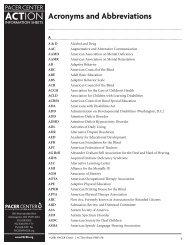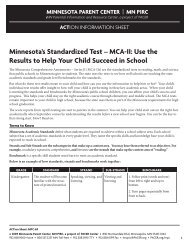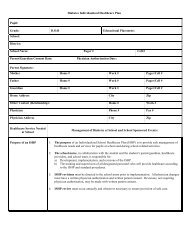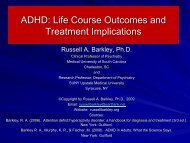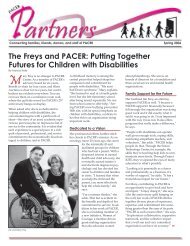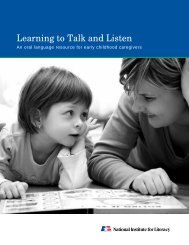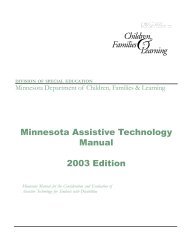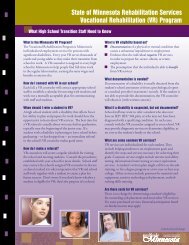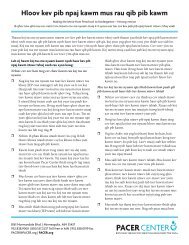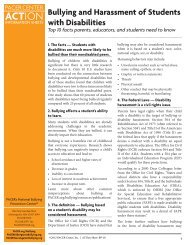How Will I Know If My Child is Making Progress? - Parent Center ...
How Will I Know If My Child is Making Progress? - Parent Center ...
How Will I Know If My Child is Making Progress? - Parent Center ...
Create successful ePaper yourself
Turn your PDF publications into a flip-book with our unique Google optimized e-Paper software.
A L L I A N C E<br />
ACTion<br />
INFORMATION SHEETS<br />
<strong>How</strong> <strong>Will</strong> I <strong>Know</strong> <strong>If</strong> <strong>My</strong> <strong>Child</strong> <strong>is</strong> <strong>Making</strong><br />
<strong>Progress</strong><br />
ALLIANCE<br />
ALLIANCE<br />
ALLIANCE<br />
ALLIANCE<br />
ALLIANCEALLIANCEALLIANCE<br />
ALLIANCE<br />
ALLIANCE<br />
Technical Ass<strong>is</strong>tance ALLIANCE<br />
for <strong>Parent</strong> <strong>Center</strong>s<br />
8161 Normandale Blvd.<br />
Minneapol<strong>is</strong>, MN 55437-1044<br />
952.838.9000<br />
952.838.0190 TTY<br />
952.838.0199 fax<br />
888.248.0822 National Toll-free<br />
alliance@taalliance.org<br />
www.taalliance.org<br />
<strong>Child</strong>ren go to school to learn, of course. But<br />
parents of children with d<strong>is</strong>abilities often ask,<br />
“<strong>How</strong> will I know my child <strong>is</strong> learning and making<br />
progress” <strong>Parent</strong>s can answer that question<br />
by looking at a variety of data, including information<br />
from special education and general education<br />
sources and information from outside<br />
the school.<br />
Special education sources<br />
The Individuals with D<strong>is</strong>abilities Education<br />
Act as amended in 2004 (IDEA) <strong>is</strong> the special<br />
education law that emphasizes educational outcomes<br />
for students in special education. IDEA<br />
guidelines require that schools track educational<br />
progress for children with d<strong>is</strong>abilities. Here<br />
are four of the best sources:<br />
(1) The results of a student’s most recent evaluation.<br />
Students who may have d<strong>is</strong>abilities are<br />
evaluated before special education services can<br />
begin. Th<strong>is</strong> comprehensive evaluation looks at<br />
cognitive and behavioral factors, as well as physical<br />
and developmental factors in all areas of<br />
suspected d<strong>is</strong>ability. The initial evaluation provides<br />
a baseline for measuring progress and developing<br />
an individualized education program<br />
(IEP). Once a child has an IEP, the school will<br />
reevaluate or review ex<strong>is</strong>ting evaluation data at<br />
least once every three years. You can compare<br />
the most recent evaluation report with earlier<br />
reports to gauge your child’s progress. <strong>Parent</strong>s<br />
have a right to obtain copies of evaluation summaries<br />
and to have the information explained<br />
to them.<br />
(2) Measurable annual goals. Your child’s<br />
IEP must include measurable annual goals.<br />
For each goal area, the IEP must record your<br />
child’s beginning level of performance, either in<br />
a section on “present levels of educational performance”<br />
or in the goal statement. Each goal<br />
statement must outline the skills or behaviors to<br />
be changed, the direction of the desired change,<br />
and the expected ending level of performance.<br />
You will receive reports outlining your child’s<br />
progress toward meeting these goals.<br />
©2006 PACER <strong>Center</strong> | ALLIANCE ACTion Sheet: ALL-13<br />
(3) <strong>Progress</strong> reports. The IEP document must<br />
identify how often your child’s progress toward<br />
annual goals will be measured and how you will<br />
be informed of the progress. <strong>Parent</strong>s must be informed<br />
at least as often as parents are informed<br />
of their nond<strong>is</strong>abled child’s progress. Periodic<br />
report cards, other written reports, and meetings<br />
are among the many ways parents can keep<br />
informed about their child’s progress. These<br />
sources of information help parents determine<br />
whether their child’s progress <strong>is</strong> sufficient to<br />
achieve the IEP’s goals within that IEP year.<br />
(4) Annual IEP review. A new IEP <strong>is</strong> written annually<br />
for children in special education. The IEP<br />
must include a statement of the child’s present<br />
level of educational performance. <strong>Parent</strong>s can<br />
compare th<strong>is</strong> statement to the statement made<br />
the previous year. For example, how much has<br />
the child’s reading level advanced <strong>How</strong> much<br />
has the child’s on-task behavior increased<br />
Regular education sources<br />
<strong>Child</strong>ren with d<strong>is</strong>abilities have the right to participate<br />
in the general curriculum—the curriculum<br />
used for nond<strong>is</strong>abled students—whenever<br />
appropriate. <strong>Parent</strong>s can receive additional<br />
information from regular education sources.<br />
(1) Classroom teacher information. <strong>If</strong> your<br />
child participates in a regular classroom for all<br />
or any part of a day, you can attend teacher’s<br />
conferences, open houses, and other typical<br />
school events for more information, observations,<br />
and feedback about your child’s progress.<br />
Daily work, test scores, and report cards can<br />
also provide valuable information.<br />
(2) D<strong>is</strong>trictwide assessments. Students have a<br />
right to participate in d<strong>is</strong>trictwide assessments<br />
as appropriate. Examples include the Iowa Basic<br />
Skills Test (IBST) and the California Achievement<br />
Test (CAT). These tests compare the academic<br />
achievement of students across age or<br />
grade level. You can also use these tests to see if<br />
your child <strong>is</strong> making progress when the test <strong>is</strong><br />
admin<strong>is</strong>tered from year to year.<br />
1
(3) Statewide assessments. <strong>Child</strong>ren with d<strong>is</strong>abilities also<br />
have a right to be included in statewide assessment programs,<br />
with appropriate accommodations or modifications to the test<br />
if necessary. <strong>If</strong> the IEP team determines a child cannot participate<br />
in statewide testing, even with accommodations, the<br />
school must use an alternative assessment for the student.<br />
(4) No <strong>Child</strong> Left Behind Act. <strong>Child</strong>ren with d<strong>is</strong>abilities have<br />
a right to be included when schools are evaluated annually to<br />
ensure that all students make academic progress. <strong>Parent</strong>s will<br />
be informed of how well the child’s school <strong>is</strong> doing in educating<br />
certain groups of children, including those with d<strong>is</strong>abilities.<br />
Information from outside the school<br />
School <strong>is</strong>n’t the only source of information on a child’s educational<br />
progress. Independent evaluation and less formal observations<br />
can provide a fuller picture of a child’s progress.<br />
Independent evaluation<br />
<strong>Child</strong>ren can be assessed at nonschool facilities, sometimes at<br />
the expense of the school d<strong>is</strong>trict and sometimes at the family’s<br />
expense. In either case, independent evaluation results can be<br />
compared to previous testing and other progress indicators.<br />
What if my child <strong>is</strong> not making progress<br />
<strong>If</strong> you think your child <strong>is</strong> not making meaningful educational<br />
progress, you can request a meeting to d<strong>is</strong>cuss rev<strong>is</strong>ions to<br />
the child’s IEP. The school cannot guarantee that a child will<br />
achieve the goals in the IEP; however, the school must make a<br />
“good faith effort” to ass<strong>is</strong>t the child to do so.<br />
An IEP team meeting can be held to d<strong>is</strong>cuss and plan rev<strong>is</strong>ions<br />
to improve opportunity to make progress. Your child may need<br />
changes in:<br />
• special education or related services<br />
• ass<strong>is</strong>tive technology<br />
• curriculum or method of instruction<br />
• educational setting<br />
<strong>If</strong> your IEP team cannot agree whether or not your child <strong>is</strong><br />
making meaningful progress, additional evaluation to provide<br />
educational data may be needed. (For more on evaluation see<br />
ALLIANCE handout “Evaluation: What Does It Mean for Your<br />
<strong>Child</strong>”)<br />
Observing skills at home and in the community<br />
You can observe whether your child has generalized a skill<br />
taught in school. Th<strong>is</strong> means that your child can use the skill<br />
in many environments, such as the home and community, as<br />
well as in school. For example, <strong>is</strong> your child’s speech understandable<br />
at home and to the server in the restaurant Can your<br />
child do the math worksheet on money and count the change<br />
received at the store Can your child do th<strong>is</strong> skill better than he<br />
or she could last year<br />
2



